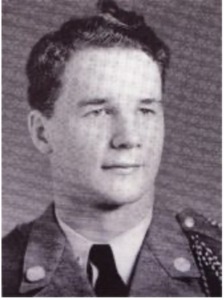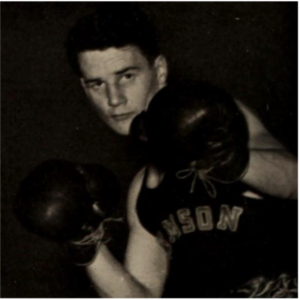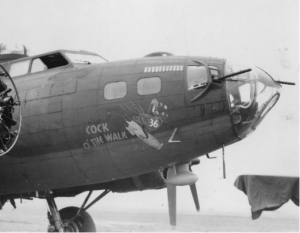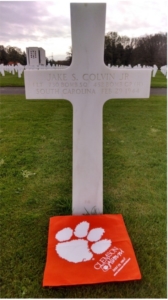Scroll of Honor – Jake S. Colvin, Jr.
High Level
Jake Stone Colvin, Jr. achieved at a high level in so many different walks of life:  academics, athletics, leadership, and service to his country during time of war.
academics, athletics, leadership, and service to his country during time of war.
Colvin, the son of Mr. and Mrs. Jake S. Colvin, Sr. of Chester, was a member of the Clemson College Class of 1942. An industrial education major, Jake was an honor student. He marched with the Pershing Rifles and as a senior, served as commanding officer of L Company, 3rd Battalion, 2nd Regiment with the rank of cadet captain. He attended ROTC summer training at Clemson in 1941, qualifying as a marksman. His military prowess earned him an invitation into Scabbard and Blade, the military honor society. He was also a member of Blue Key and the Central Dance Association, which he served as president. A boxer, Colvin punched in the 155 pound weight class  and served as the team’s alternate captain, earning membership in the Block “C” Club.
and served as the team’s alternate captain, earning membership in the Block “C” Club.
With his impressive collegiate record, it’s not surprising that Colvin was accepted into Army Air Force flight training following his graduation and commissioning. Flight training carried Colvin to Maxwell Field, Alabama; Douglas, Georgia; Greenwood, South Carolina; Lawrenceville, Illinois; and Columbus, Ohio. As he progressed through the stages of flight training, he qualified as a pilot on the Army Air Force’s workhorse heavy bomber, the B-17 Flying Fortress.
By February 1944, First Lieutenant Colvin was flying the big bombers with the 730th Bomb Squadron of the 452nd Bomb Group based at Deopham Green airfield in England. On Leap Day, February 29, Colvin and his crew were alerted to fly a mission with a twist. Instead of flying one of the bombers from their own group, their orders were to report to the 388th Bomb Group at nearby Knettishall air base to fly Cock O’ the Walk, one of that group’s aircraft.
Despite this change of station, the mission started off routinely with more than two hundred 8th Air Force bombers sliding into formation in the skies over East Anglia before heading east across the North Sea. A good beginning was essential, because this day’s mission was no “milk run.” The target was aircraft production factories in Brunswick, Germany.
By the time the formation reached Brunswick shortly after 1100 hours,  cloud cover was solid. That may have accounted for the absence of enemy fighters. Still, the bombers had to be concerned with German anti-aircraft fire, or flak, which with radar guidance could “see” through the clouds. Likewise, the bomber formation was relying on its own radar to identify its target. Lead aircraft, equipped with targeting radar, signaled the rest of the formation to release bombs by firing flares. Bombs away occurred at 1116 hours from an altitude of 21,000 feet.
cloud cover was solid. That may have accounted for the absence of enemy fighters. Still, the bombers had to be concerned with German anti-aircraft fire, or flak, which with radar guidance could “see” through the clouds. Likewise, the bomber formation was relying on its own radar to identify its target. Lead aircraft, equipped with targeting radar, signaled the rest of the formation to release bombs by firing flares. Bombs away occurred at 1116 hours from an altitude of 21,000 feet.
Immediately after releasing its bomb load, while its bomb bay doors were still open, Colvin’s aircraft was struck in the bomb bay by German flak, creating a great explosion. According to the plane’s navigator, Second Lieutenant Allan Johnson, the blast killed Jake Colvin and mortally wounded the copilot. The ball turret gunner and one of the waist gunners were also killed. With the plane on fire and falling earthward, Johnson and five other crew members were able to bail out. They would be taken prisoner. The plane crashed just outside of Brunswick. Although fifty-four bombers were damaged during the mission, Colvin’s was the only one lost.
First Lieutenant Jake Colvin was survived by his parents, two sisters and a brother.  After the war, his body was buried at the Ardennes American Military Cemetery, Belgium. He is also memorialized by a marker in Chester’s Evergreen Cemetery.
After the war, his body was buried at the Ardennes American Military Cemetery, Belgium. He is also memorialized by a marker in Chester’s Evergreen Cemetery.
For more information about Jake Stone Colvin, Jr. see:
https://soh.alumni.clemson.edu/scroll/jake-stone-colvin-jr/
For additional information about Clemson University’s Scroll of Honor visit:
https://soh.alumni.clemson.edu/
Cock O’ the Walk photo courtesy Imperial War Museum, http://www.americanairmuseum.com/aircraft/4833
